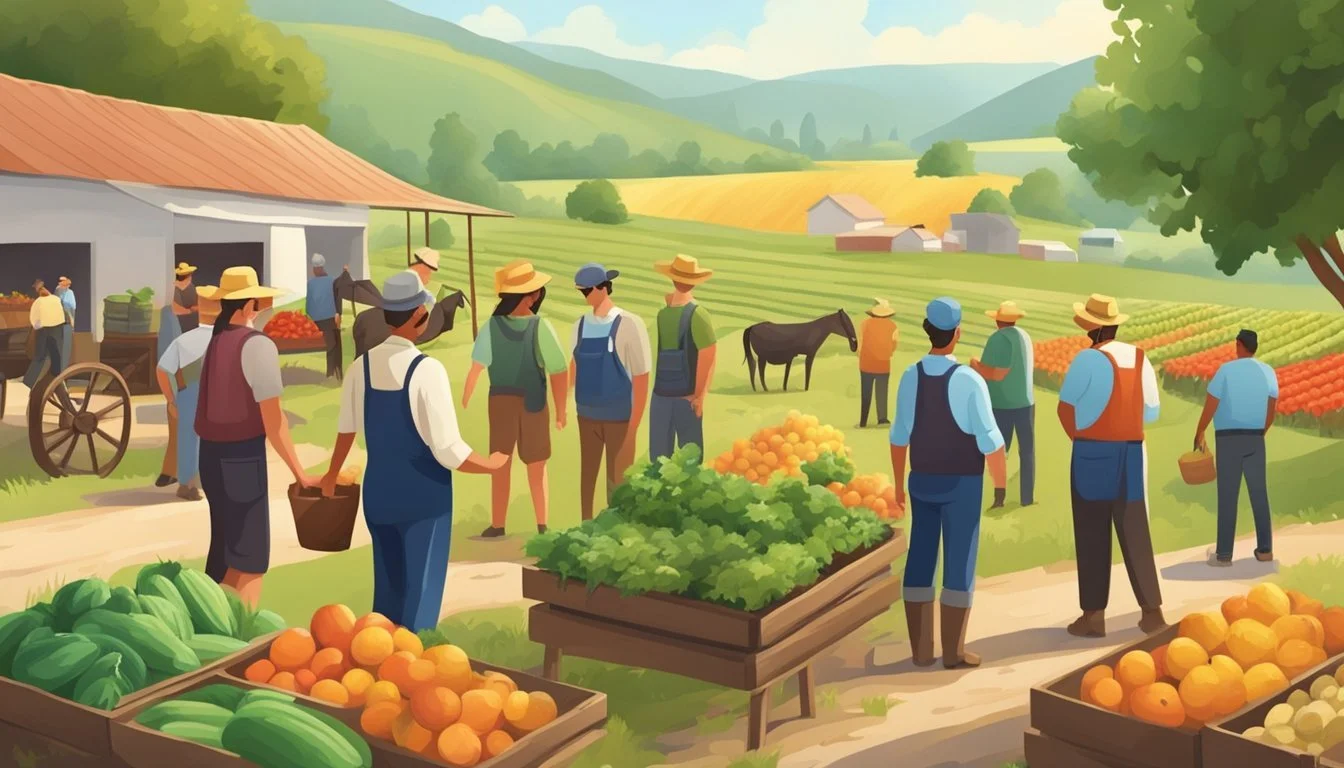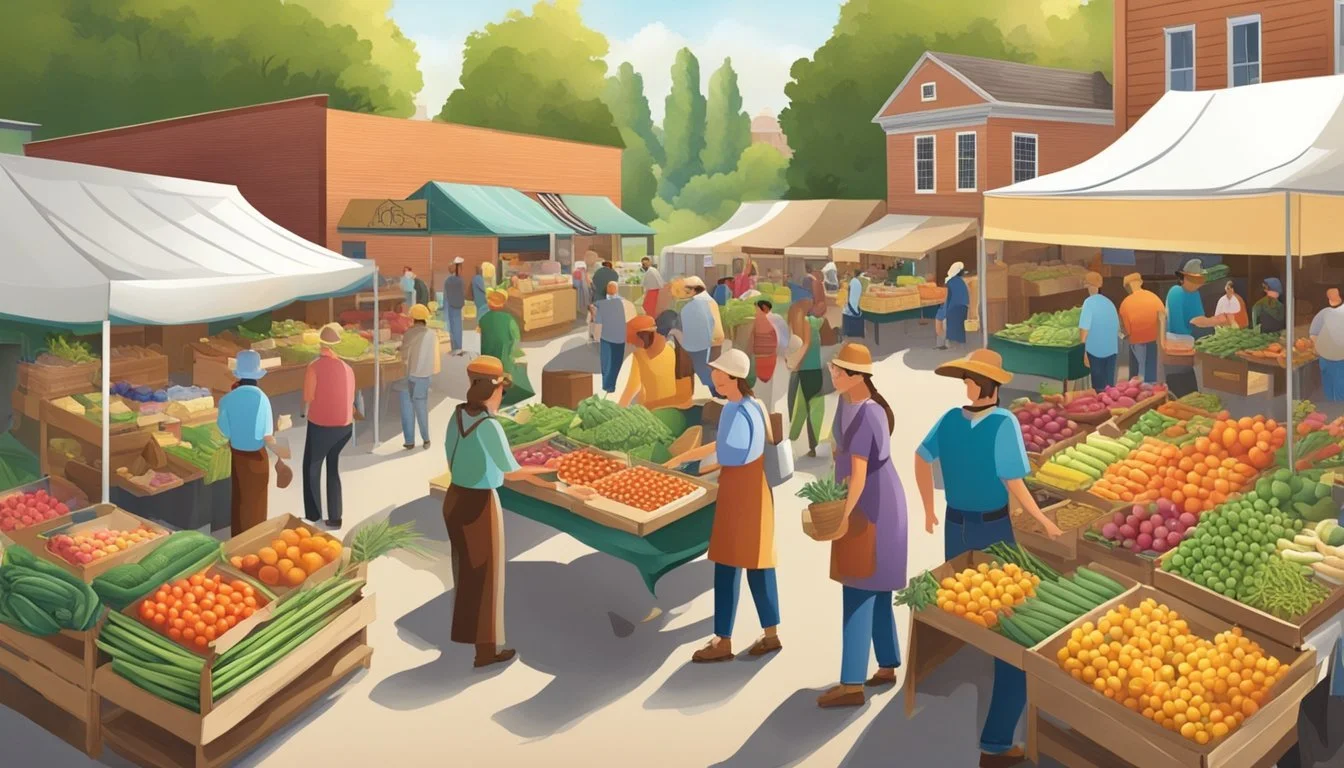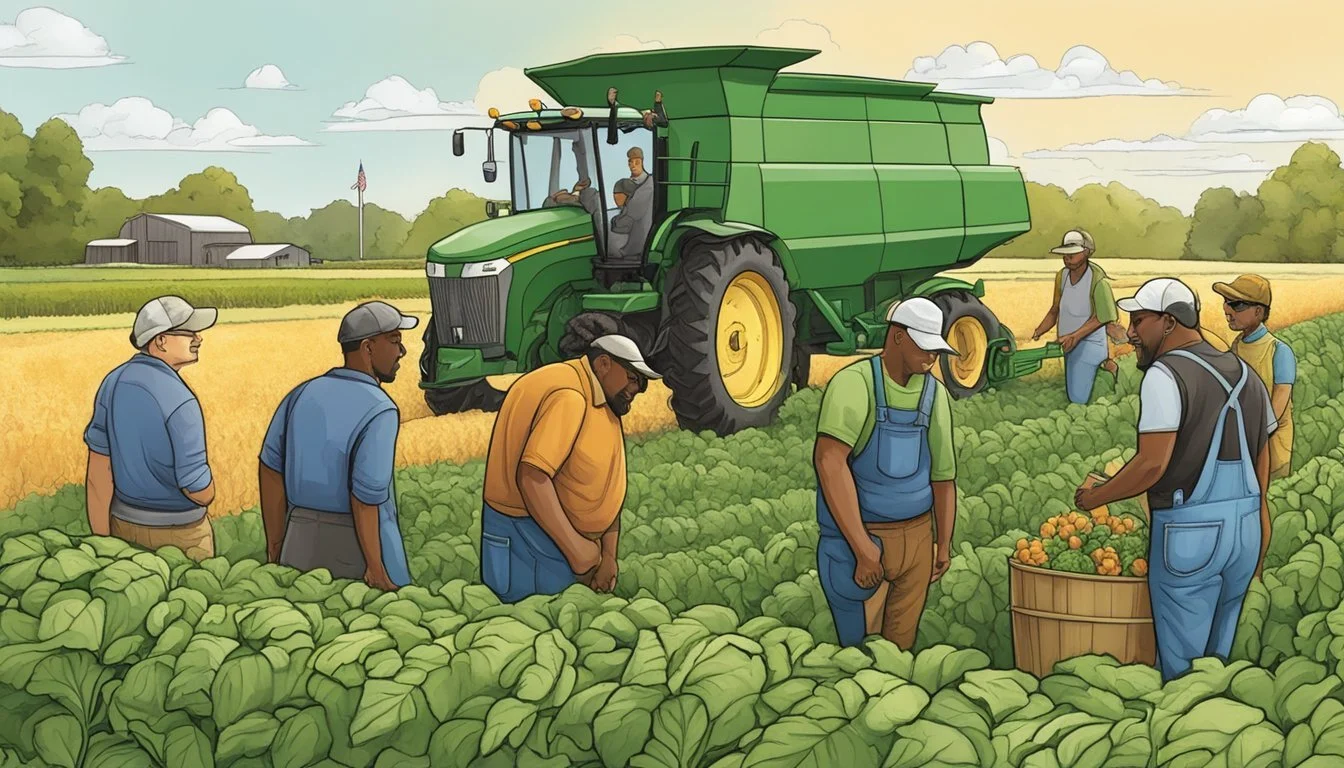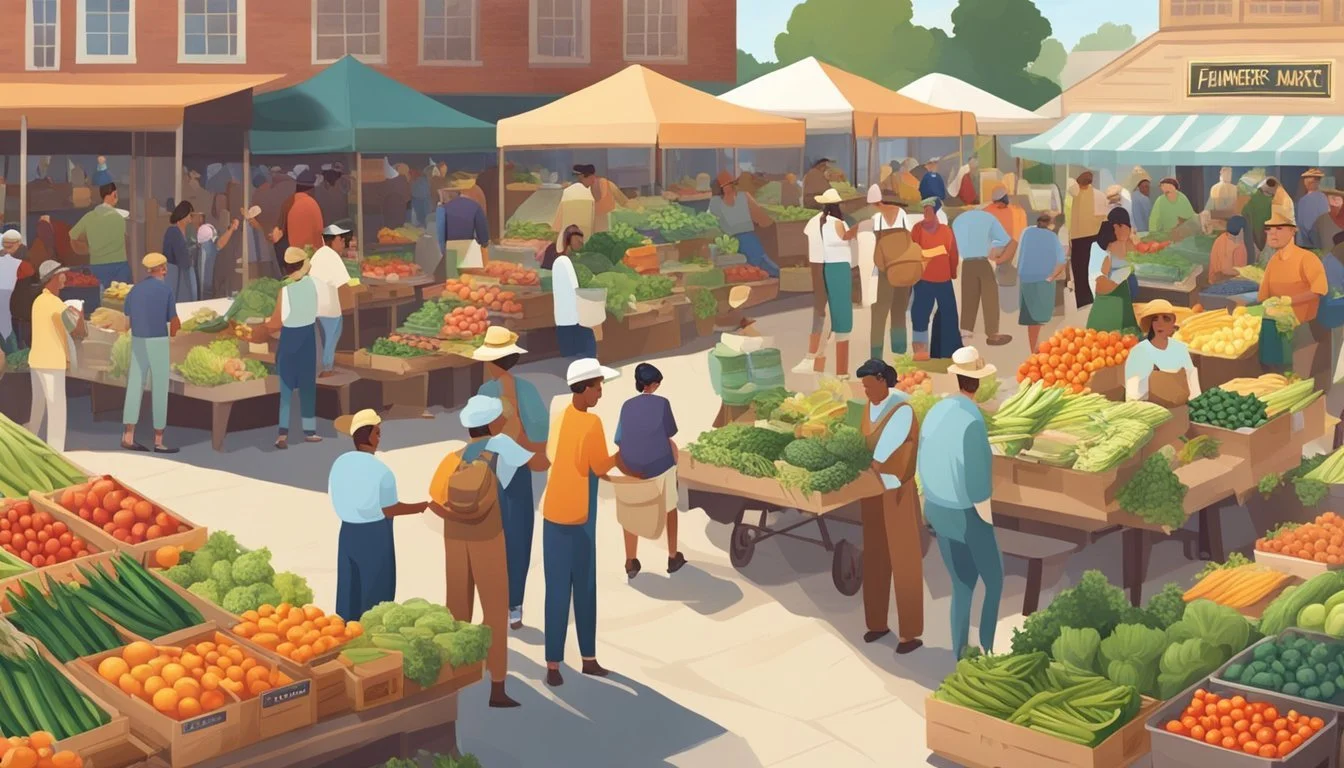Community Supported Agriculture (CSA) in Illinois
Thriving Local Farms and Food Security
Community Supported Agriculture (CSA) represents a vibrant segment of Illinois' approach to local and sustainable agriculture. In this system, consumers purchase subscriptions from their local farms, securing a season's worth of fresh produce and, in some cases, additional farm products. These subscriptions not only guarantee consumers a regular supply of farm-fresh goods but also provide farmers with upfront capital to support the growing season's expenses. The mutual commitment fosters a stronger connection between Illinois residents and the farmers who feed them, emphasizing the value of understanding where and how one's food is produced.
The CSA model in Illinois is supported by programs like those offered by the University of Illinois Extension, which educates the public on the benefits and practices of CSA shopping. This model has adapted over time to meet the needs of a diverse consumer base and has expanded beyond just vegetables to include a variety of locally-produced farm products. With an array of farms participating in the CSA framework, residents have ample opportunity to engage with agriculture on a personal level.
Illinois' CSA directory further simplifies the process for consumers to find and engage with local farms. Farms listed in the directory provide regular deliveries of produce and other products on a subscription or membership basis, covering one or more harvest seasons. The structure of CSA allows Illinois consumers to support local farmers throughout the year while enjoying the richness and variety of fresh, locally grown food.
Understanding CSA
Community Supported Agriculture (CSA) represents a unique model of agricultural production and distribution that ties local Illinois producers with community members. This mutually beneficial system underscores the importance of sustainable practices and strengthens the local food system.
History of CSA in Illinois
In Illinois, the CSA model has a storied past, reflecting a shift towards sustainable agriculture. Its roots date back to the 1980s, coinciding with a broader national movement that saw consumers and farmers forging direct relationships. Unlike traditional retail models like farmers markets, Illinois CSAs epitomize a shared commitment where consumers contribute upfront, creating a financial foundation for the entire growing season.
CSA Basics
A CSA model functions on the concept of shares. Illinois residents purchase a share from their local CSA farm, which translates to a seasonal supply of fresh produce, and occasionally other items like meats or eggs.
Share Types:
Full Share: Ideal for families, provides a weekly array of products.
Half Share: Suited for individuals or small families, bi-weekly options exist.
Subscription Period:
Most CSAs run from late spring to early fall; however, some offer year-round subscriptions.
Participation in a CSA demands an upfront investment before the harvest season, mitigating the financial risks for the farmers.
Benefits of Joining a CSA
Joining a CSA in Illinois comes with an array of advantages for both the consumer and the producer.
Benefits for Consumers:
Access to fresh, locally-sourced produce.
Exposure to new varieties of fruits and vegetables.
Opportunities to learn about sustainable agriculture and seasonal eating.
Benefits for Producers:
Upfront capital for the growing season.
Reduced marketing costs.
Strengthened farmer-consumer relationships.
These benefits serve to bolster the local food economy, support environmentally responsible farming, and promote community health.
How CSA Works
Community Supported Agriculture (CSA) in Illinois is a model that hinges on a partnership between local farms and community members, establishing a system of seasonal produce subscription that underpins local agriculture.
Membership and Subscription
In Illinois, CSA members subscribe to a local farm by purchasing a share at the onset of the growing season. This financial commitment supports the farm's operations, while in return, members are entitled to receive a portion of the farm's harvest throughout the season. The membership operates much like a subscription model, where consumers pay upfront to secure their share of the forthcoming harvest.
The Seasonality of Produce
CSA shares are reflective of the season's bounty in Illinois. As plants have specific growing times, the variety of produce members receive changes throughout the year. This inherently educates members on the local seasonal produce calendar and fosters a connection between their food consumption and the natural agricultural cycles.
Understanding Share Types
CSA programs in Illinois may offer a diversity of share options to cater to different preferences and needs:
Traditional Shares: These consist of a variety of seasonal vegetables chosen by the farmer, with the possibility of including fruits, herbs, and other farm products like eggs or honey.
Market-Style Shares: Some CSAs allow subscribers to choose a selection of produce up to a certain value, similar to shopping at a farmers’ market.
Each type of share reinforces the CSA’s mission to provide fresh, seasonal, and locally-grown food to the community while promoting sustainable farming practices.
Benefits of CSA
Community Supported Agriculture offers multi-faceted advantages, impacting local communities, farmers, and the environment by fostering sustainable practices and healthy food options.
For Local Communities
Community involvement in CSAs bolsters local economies by ensuring that food dollars stay within local boundaries. Individuals have access to fresh, locally-grown produce, which typically surpasses the nutritional quality of products that endure long transport. Additionally, CSA members directly support the resilience and sustainability of their local food systems.
Economic Support: Money spent with local farms circulates within the community.
Access to Nutritious Food: Communities enjoy the benefits of having freshly harvested food.
For Farmers
Farmers engaged in CSAs receive upfront capital, which aids in the planning and budgeting for the season. This model also allows for a guaranteed market for their harvest, reducing the financial risks commonly associated with farming. By connecting directly with consumers, farmers can get immediate feedback and build lasting relationships with their customer base.
Financial Stability: Pre-season payments from CSA members stabilize farm cash flow.
Customer Relationships: Direct interaction with consumers strengthens their community presence.
For the Environment
CSA practices promote environmental stewardship through sustainable agricultural methods. By reducing the distance food travels, CSAs lower carbon footprints, thus contributing to the health of the planet. Moreover, sustainable farming techniques often used in CSAs, such as organic farming, enhance soil fertility and biodiversity.
Reduced Transport: Local distribution leads to less fuel consumption and pollution.
Sustainable Farming: Emphasis on environmentally friendly practices benefits the ecosystem.
Finding CSAs in Illinois
Community Supported Agriculture (CSA) programs in Illinois provide consumers with direct access to high-quality, locally-grown produce. This section outlines how one can find and utilize CSA programs throughout the state, including directories and regional availability, and the variety of offerings.
CSA Directories
To locate a CSA in Illinois, prospective members should consult online directories that list local farms involved in such programs. The Illinois Extension of the University of Illinois at Urbana-Champaign offers a comprehensive listing of CSAs. Additionally, websites like LocalHarvest are useful resources that provide information on CSAs, allowing users to search by location, such as Metro Chicago or counties like Champaign, Boone, and Kane.
Regional Availability
CSAs are widespread across Illinois, encompassing both urban settings like Chicago and rural areas. Significant concentrations are found near large metro areas with numerous offerings in Chicago itself. Surrounding counties of the metro area, including DuPage, Woodford, and LaSalle, also feature diverse CSA options. Some farms advertise at Farmers Markets indicating the presence of CSAs in Stark County and beyond.
CSA Programs and Offerings
Illinois CSAs present a range of products from local farms—ranging from vegetable shares to grass-fed meats. For instance, Mint Creek Farm in Stelle, IL, emphasizes grass-fed meats and is one example among many that tailor CSA offerings to include meats, dairy, or specific types of crops. CSA members might collect their shares via home delivery, mail shipping, or pickup at designated locations, with some farms providing options to adjust frequency and size of CSA boxes throughout the seasons.
Types of Products Offered
Community Supported Agriculture in Illinois provides a broad range of farm-fresh products directly to consumers through various subscription plans, commonly known as "shares." These shares often include seasonal produce, meats, and a variety of other farm products that enhance the local food experience.
Vegetable and Fruit Shares
Vegetable and fruit shares are staples of CSA offerings. Subscribers can enjoy a diverse array of seasonal produce, including tomatoes, peppers, squashes, leafy greens, and root vegetables like kohlrabi. Fruit selections vary based on seasonality but often include items such as apples, peaches, berries, and melons. These shares are celebrated for their freshness and nutritional value.
Meat and Eggs
Alongside produce, CSA members may have the option to subscribe for meat and egg shares. Livestock raised locally on sustainable farms can result in an assortment of meats such as beef, pork, chicken, and sometimes lamb. Additionally, farm-fresh eggs are often available, providing a reliable source of high-quality protein.
Additional Farm Products
Beyond the typical produce and meat options, Illinois CSAs may offer an expanded selection of products. This can include but is not limited to:
Honey: Harvested locally, providing natural sweetness and regional flavors.
Herbs: Freshly picked, including varieties such as basil, cilantro, and thyme which are perfect for enhancing dishes.
Cheese: Artisanal cheeses made from the milk of farm-raised animals.
Bread: Often baked locally using traditional methods, sometimes with organic grains.
Subscribers to CSAs can thus partake in a holistic sampling of what Illinois farms have to offer.
Managing CSA Relationships
In Illinois, managing relationships within Community Supported Agriculture (CSA) is crucial to their success. Effective relationship management not only ensures a stable subscriber base but also fosters a sense of community and shared commitment between farmers and customers.
Building Farmer-Customer Bonds
Farmers create lasting bonds with customers by providing regular updates on crop progress and inviting them to farm events. This transparent communication enhances trust and keeps subscribers engaged with the day-to-day life of the farm. By treating shareholders as a part of the farm's journey, farmers cultivate a loyal community around their CSA.
Communicating with CSA Members
Communication is the linchpin in the relationship between CSA managers and their members. Regular, clear updates about what is happening on the farm, what to expect in delivery boxes, and other pertinent details are essential. This may take the form of:
Weekly newsletters: These often include a list of the week's available produce, recipes, and farm news.
Social media updates: A quick, engaging way to keep members informed and interested.
Member surveys: An excellent tool for understanding member preferences and improving the CSA experience.
Shared Risks and Rewards
A foundational aspect of CSA is sharing risk between the farmer and the subscribers. Both parties understand that while bountiful harvests result in a windfall of produce, difficult seasons may result in smaller shares. This is often communicated clearly from the onset, fostering a shared responsibility and a real understanding of the challenges of farming. Subscribers become more than customers; they are partners in the agricultural process.
Challenges and Considerations
Community Supported Agriculture (CSA) in Illinois offers many benefits but also confronts several challenges that affect both farms and their members. Understanding these challenges is crucial for the sustainability of local CSAs.
Weather Impacts on CSA Farming
Illinois' CSA farms, such as Tomato Mountain Farm, must navigate the state's variable weather patterns. The growing season can be disrupted by unexpected frost, heatwaves, or severe storms. This variability can lead to fluctuations in produce yield and quality, directly impacting the offerings available to CSA subscribers. McHenry County and other local regions may experience unique microclimates that further complicate these weather challenges.
Key Weather Concerns:
Unexpected frost or heatwaves
Severe storms and precipitation
Impact on yields and quality of produce
Seasonal Variations in Product Availability
The very nature of CSA means that members receive seasonal produce directly from their local farm. Consequently, the diversity of available produce can vary substantially from one part of the growing season to the next. Spring may offer a bounty of leafy greens, while late summer could bring a wealth of tomatoes and corn. Members often need education on seasonal eating and expectations to understand the fluctuations in their CSA shares.
Typical Seasonal Produce:
Spring: leafy greens, radishes, peas
Summer: tomatoes, corn, zucchini
Fall: pumpkins, apples, root vegetables
Logistics: Pickup and Delivery Options
CSAs like Tomato Mountain Farm in Illinois often provide a choice between pickup and delivery options to their members. Efficiently managing these logistics is a significant challenge, as farms must balance cost, convenience, and carbon footprint considerations. Members living in more remote areas might face difficulties with pickup locations or may have limited delivery service, which can affect participation and satisfaction with the CSA program.
Logistics Options:
Pickup: Designated local sites on specific days/times
Delivery: Direct to home or office; may incur additional cost or be limited to certain areas
Each of these challenges requires careful consideration and planning by both CSA management and members to ensure a successful and mutually beneficial relationship.
Supporting CSA Beyond Subscriptions
Community Supported Agriculture (CSA) programs in Illinois offer more than just subscription boxes of local produce; they involve significant interaction and education within the community, as well as opportunities for direct marketing efforts. These programs benefit both consumers and producers by fostering a deeper connection to the local food system.
Community Involvement and Education
CSAs provide unique outlets for community engagement. Many CSA farms encourage member participation in farm events, volunteer opportunities, and educational programs. Local food directories often list these farms, making it easier for community members to find and participate in these valuable experiences. Educational initiatives are fundamental in teaching community members about sustainable farming practices and benefits of locally-grown food. For example, cooking classes, workshops on seasonal recipes, and tips on food preservation help to enhance members’ knowledge and promote the importance of CSA within the local food economy.
Direct Marketing Opportunities
For CSA farmers, direct marketing is a cornerstone of extending their reach and success. By selling products directly to consumers at farmers' markets, farm stands, or online platforms, farmers can gain additional revenue and customer loyalty. Marketing efforts often include valuable information about the origins of the local produce, farming methods used, and the stories behind the farms. This transparency helps in building trust and a sense of community between consumers and growers. CSA programs can harness these opportunities to improve their visibility in the market and create a stable economic foundation for local agricultural endeavors. Direct marketing also educates consumers about the role they play in sustaining the viability of small-scale, local farms through various purchasing channels.
Notable Illinois CSAs
Illinois boasts a variety of Community Supported Agriculture (CSA) programs, each providing a direct connection between local farmers and consumers. Notable farms such as Angelic Organics, Cedar Valley Sustainable Farm, and Prairie Wind Family Farm exemplify the diversity and commitment to sustainable agriculture found in the state.
Angelic Organics
Angelic Organics is a leader in the Illinois CSA community, serving the Chicago area with its biodynamic and organic produce. Members receive a weekly share of vegetables, fostering a direct and supportive relationship between the farm and its CSA subscribers.
Cedar Valley Sustainable Farm
Cedar Valley Sustainable Farm offers a unique approach to CSA by focusing on meat production. Subscribers can indulge in a range of grass-fed meats and pastured poultry, knowing they are consuming products from animals raised on organic pastures.
Prairie Wind Family Farm
Prairie Wind Family Farm, representing another thriving Illinois CSA, also caters to local consumers through subscription-based services. The farm's offerings not only include a rich variety of organic vegetables but also extend to other farm products in a commitment to promoting local, sustainable agriculture.
Exploring CSA Innovations
Community Supported Agriculture (CSA) programs in Illinois are employing technological advances and creative subscription models to enhance their offerings to subscribers and improve overall farm management.
Technological Advances in CSA Management
CSA programs across Illinois are leveraging technology to streamline operations and improve the consumer experience. Innovations include user-friendly online platforms that allow subscribers to manage their subscriptions easily. These platforms often integrate with inventory management systems, providing real-time updates on product availability and enabling efficient management of CSA shares.
Specific technologies benefiting CSA programs:
Automated Communication Tools: Simplify updates between farmers and subscribers.
Data Analytics: Optimize crop planning and forecast demand.
Mobile Applications: Facilitate ordering and share customization.
Additionally, some CSA farms are adopting hoop houses—a form of greenhouse technology—to extend growing seasons and provide a wider variety of produce options year-round.
Creative Subscription Models
In response to consumer demand for flexibility, CSA programs in Illinois are designing flexible subscription options. These models vary from traditional fixed-term subscriptions and often allow subscribers to choose the frequency and quantity of produce delivery.
Examples of flexible subscription options include:
On-Demand Subscriptions: Subscribers may opt into a CSA delivery with less regularity, aligning with their needs.
Market-Style Shares: Subscribers have the option to select their produce at a designated pickup location, mirroring a farmers market experience.
Adjustable Share Sizes: Tailoring subscriptions based on household size or consumption patterns.
By introducing these innovations, CSA programs aim to cater to a wider audience, improving accessibility and convenience for their subscribers.
Recipes and Cooking Tips
Community Supported Agriculture in Illinois offers an abundance of fresh, seasonal produce that lends itself to a healthier diet through flavor-packed, nutritious recipes. Here are ways to utilize CSA offerings effectively in the kitchen.
Using Seasonal Produce
Cooking with seasonal produce ensures that individuals benefit from the peak flavor and nutritional value of the vegetables and fruits provided in their CSA box. For example, a spring CSA box might contain asparagus, which can be used in a simple stir-fry or as a side dish roasted with garlic and olive oil. When it's berry season, incorporating fresh berries into salads or desserts maximizes their natural sweetness and health benefits.
Spring Recipes:
Asparagus: Roasted with a drizzle of olive oil and garlic.
Berries: Tossed in a mixed green salad with vinaigrette.
Summer Recipes:
Bell Pepper: Sautéed with onions for a colorful fajita filling.
Swiss Chard: Blanched and incorporated into a light pasta dish.
Fall Recipes:
Kohlrabi: Similar to the method from a search result, cook it with bell pepper and spices like turmeric and mustard seeds for a warm salad.
Apples: Baked into a crisp or used raw in a tangy coleslaw.
Incorporating CSA Ingredients
Introducing new vegetables from a CSA box into one's diet can be both exciting and intimidating. To incorporate unfamiliar items like kohlrabi, a cooking technique from the aforementioned search result, such as stir-frying with complementary spices, can transform it into a vibrant dish. When faced with abundant greens, one can make pesto or a hearty green soup, both of which are delicious and healthy ways to consume large quantities of greens before they wilt.
New Vegetable Ideas:
Kohlrabi: Stir-fried with bell peppers, turmeric, and mustard seeds.
Swiss Chard: Wilted into soups or chopped into stews for added nutrition.
Health-conscious consumers may opt for recipes that correspond with their dietary needs, recognizing that CSA produce is typically fresher, potentially organic, and full of vitamins. Cooking at home with ingredients from a CSA share encourages a nutritious lifestyle and an appreciation for the region's seasonal bounty.











